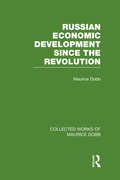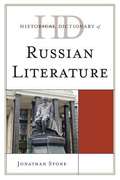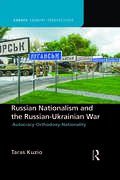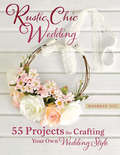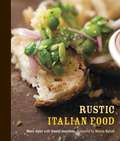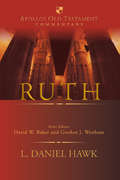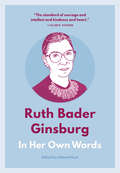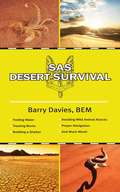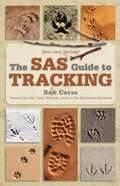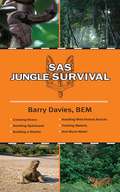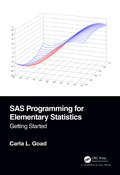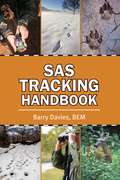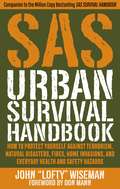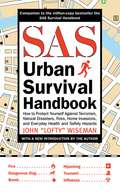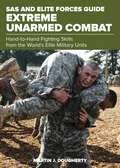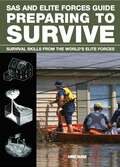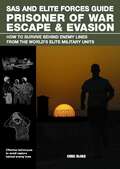- Table View
- List View
Russian Bible Wars
by Stephen K. BataldenAlthough biblical texts were known in Church Slavonic as early as the ninth century, translation of the Bible into Russian came about only in the nineteenth century. Modern scriptural translation generated major religious and cultural conflict within the Russian Orthodox church. The resulting divisions left church authority particularly vulnerable to political pressures exerted upon it in the twentieth century. Russian Bible Wars illuminates the fundamental issues of authority that have divided modern Russian religious culture. Set within the theoretical debate over secularization, the volume clarifies why the Russian Bible was issued relatively late and amidst great controversy. Stephen Batalden's study traces the development of biblical translation into Russian and of the 'Bible wars' that then occurred in the nineteenth and twentieth centuries in Russia. The annotated bibliography of the Russian Bible identifies the different editions and their publication history.
Russian Economic Development Since the Revolution (Business Enterprises Reprint Ser.)
by Maurice DobbThe story of the economic development of the Soviet Union provided the first case in history of the establishment of a socialist economy and was therefore of great interest for economists and economic historians of the twentieth century. At the same time it affords a unique example of the transformation of a country into an industrial nation at an unprecedented pace and under the guidance of a national economic plan. This book examines these changes from the Russian Revolution of 1917 to 1927.
Russian Literature (Historical Dictionaries of Literature and the Arts)
by Jonathan StoneRussian literature is most celebrated for its Romantic and modernist poetry and 19th-century novels. While literary traditions of varying sorts have been part of Slavic and Russian culture for over a millennium, it is only since the 18th century that they came to resemble literature from the West. <P><P>The Historical Dictionary of Russian Literature contains a chronology, an introductory essay, appendixes, and an extensive bibliography. The dictionary section has over 100 cross-referenced entries on significant people, themes, critical issues, and the most significant genres that have formed Russian Literature. This book is an excellent access point for students, researchers, and anyone wanting to know more about Russian literature.
Russian Literature and the Classics (Routledge Harwood Studies in Russian and European Literature)
by Paul Allen Miller Peter I. Barta David H. J. LarmourRussian Literature and the Classics attempts to fill a gap. To date there has been no book-length, systematic study of the impact of antiquity on Russian literature and culture. While by no means claiming to offer a comprehensive approach, the authors focus on various aspects of the influence which the Classics have had on Russian literature at particularly significant junctures - the beginning of the nineteenth century; the age of the great Russian realist novel; the "Silver Age"; Stalin's terror; the "Thaw" after 1956; and the period just before the collapse of Soviet society. In their introductory essay the editors offer an overview of the Classical Tradition. In it, they provide an insight into the contrasting ways in which that tradition manifested itself in the literatures of Western Europe and of Russia.
Russian Nationalism and the Russian-Ukrainian War (Europa Country Perspectives)
by Taras KuzioThis book is the first to provide an in-depth understanding of the 2014 crisis, Russia’s annexation of Crimea and Europe’s de facto war between Russia and Ukraine. The book provides a historical and contemporary understanding behind President Vladimir Putin Russia’s obsession with Ukraine and why Western opprobrium and sanctions have not deterred Russian military aggression. The volume provides a wealth of detail about the inability of Russia, from the time of the Tsarist Empire, throughout the era of the Union of Soviet Socialist Republics (USSR), and since the dissolution of the latter in 1991, to accept Ukraine as an independent country and Ukrainians as a people distinct and separate from Russians. The book highlights the sources of this lack of acceptance in aspects of Russian national identity. In the Soviet period, Russians principally identified themselves not with the Russian Soviet Federative Republic, but rather with the USSR as a whole. Attempts in the 1990s to forge a post-imperial Russian civic identity grounded in the newly independent Russian Federation were unpopular, and notions of a far larger Russian ‘imagined community’ came to the fore. A post-Soviet integration of Tsarist Russian great power nationalism and White Russian émigré chauvinism had already transformed and hardened Russian denial of the existence of Ukraine and Ukrainians as a people, even prior to the 2014 crises in Crimea and the Donbas. Bringing an end to both the Russian occupation of Crimea and to the broader Russian–Ukrainian conflict can be expected to meet obstacles not only from the Russian de facto President-for-life, Vladimir Putin, but also from how Russia perceives its national identity.
Rust in Peace: The Inside Story of the Megadeth Masterpiece
by Dave MustaineGet a behind-the-scenes look at the making of Megadeth&’s iconic record, Rust in Peace, from the band&’s lead vocalist and guitarist.When Rust in Peace was released in 1990, the future of Megadeth was uncertain. Fresh off their performance at the record-breaking Monsters of Rock festival, and with knockout new albums from Slayer, Anthrax, and Metallica dominating the charts, the pressure to produce a standout statement record was higher than ever.In Rust in Peace: The Inside Story of the Megadeth Masterpiece, the band's lead vocalist and guitarist, Dave Mustaine, gives readers a never-before-seen glimpse into the artistry and insanity that went into making the band's most iconic record. He recounts the arduous task of hiring the band and supporting cast, of managing egos and extracurriculars during the album's ensuing success, and succumbing to the pressures of fame and fortune—which eventually forced the band to break up.And yet, Megadeth's demise was just the beginning; the birth pangs of the record were nothing compared to what came next. Alcohol, drugs, sex, money, power, property, prestige, the lies fed to the band by the industry—and the lies they told each other-threatened to eat away at the band's bond like rust, devouring it until only the music survived.Featuring a foreword by Slash
Rustic Chic Wedding: 55 Projects for Crafting Your Own Wedding Style
by Morgann HillRustic Chic Wedding is a bride and groom's peek into the vintage-inspired, timeless wedding of their dreams. A little DIY with a whiff of romance and whimsy goes a long way toward wedding-day magic.Choose from any of the three beautiful wedding "themes.” Maybe your wedding style is Shabby Vintage Couture Wedding: try the Garden Table Numbers or Monogrammed Cake Stand. Or if the Rustic, Recycled & Re-purposed Wedding is more your speed, there's a Flower Girl Crown and Kissing Bell. The Urban Farmhouse Wedding has instructions for creating a Twig Cake Topper and a S'mores Bar. However you mix and match the projects, your wedding will express your love story, inside and out!With a chapter on creating the perfect themed tablescape and one dedicated to beautiful bridal bouquets and boutonnieres, Rustic Chic Wedding will be an indispensable guide on the sweetest day of your life..
Rustic Italian Food: [A Cookbook]
by Mario Batali David Joachim Marc VetriSlow-cooked meats, homemade breads, flavorful pastas...these are the traditional comfort-food classics that Italians have been roasting, baking, curing, and making in their own kitchens for generations--dishes that people actually want to cook and eat. In Rustic Italian Food, acclaimed Philadelphia chef Marc Vetri celebrates the handcrafted cuisine of Italy, advocating a hands-on, back-to-the-basics approach to cooking. Home cooks of every skill level will revel in the 120 recipes, such as sweet Fig and Chestnut Bread, rich Spinach and Ricotta Gnocchi, savory Slow-Roasted Lamb Shoulder, and fragrant Apple Fritters. Rustic Italian Food is also an education in kitchen fundamentals, with detailed, step-by-step instructions for making terrines, dry-cured salami, and cooked sausage; a thorough guide to bread and pasta making; and a primer on classic Italian preserves and sauces. Much more than just a collection of recipes, in this book Marc Vetri connects us directly to the essence of Italian food.
Ruth (Apollos Old Testament Commentary Series)
by L. Daniel HawkOn the surface, the book of Ruth tells the tale of an unlikely marriage between a destitute Moabite widow and an upstanding citizen of a Judean village. The deeper import of the story, however, has to do with the internal boundaries that define the people of God. Is Israel a closed community, held together exclusively by bonds of kinship, or a nation that welcomes faithful outsiders into its sphere of belonging? Ruth appropriates marriage as the symbolic vehicle of a transformation in Israel?s self-understanding from a community articulated by Naomi?s declaration that her daughters-in-law marry within their own people, to the acclamations by the people of Bethlehem that endorse Boaz?s marriage to a Moabite. L. Daniel Hawk undertakes a detailed narrative analysis of Ruth that goes beyond the description of its content and stylistic features to illumine its deep structure and use of metaphor. Informed by contemporary studies on ethnicity, he discovers a work of remarkable sophistication that employs a story of intermarriage to address opposing ideas of Israelite identity. Hawk?s meticulous attention to patterned structures, stylistic devices and characterization reveals the strategy by which the narrator constructs a vision of Israel that looks beyond rigid internal boundaries to the welcome of faithful foreigners as agents of blessing.
Ruth Bader Ginsburg: In Her Own Words (In Their Own Words)
by Helena Hunt&“Like so many cultural icons, Ginsberg has doled out some seriously memorable quotes, thoughts, and observations . . . a quick dip of inspiration.&” —Bustle As one of only nine women in a class of 500 at Harvard Law School when she enrolled in 1956 and one of only four female Supreme Court justices in the history of the United States, Ruth Bader Ginsburg was frequently viewed as a feminist trailblazer and an icon for civil rights. Ginsburg had always been known as a prolific writer and speaker. Now, Ruth Bader Ginsburg: In Her Own Words offers a unique look into the mind of one of the world&’s most influential women by collecting 300 of Ginsburg&’s most insightful quotes. Meticulously curated from interviews, speeches, court opinions, dissents, and other sources, Ruth Bader Ginsburg: In Her Own Words creates a comprehensive picture of Ruth Bader Ginsburg, her wisdom, and her legacy. &“The standard of courage and intellect and kindness and heart.&” —Gloria Steinem
Ruth: A Guide to Reading Biblical Hebrew (Guide to Reading Biblical Hebrew)
by Adam J. HowellMaintain your Hebrew. Too often, a former Hebrew student is a lapsed Hebrew student. The paradigms, the syntactical forms, and even the alphabet can be hard to recall. The way to make Hebrew stick, like any language, is to continue to put it to use. In Ruth: Guide to Reading Biblical Hebrew, Adam J. Howell helps intermediate readers of Hebrew work through the text of Ruth with exegetical and syntactical aids. With Howell as a guide, students will be able to mine the riches of the Hebrew text to appreciate the literary and theological significance of the book of Ruth.
S Is for Southern: A Guide to the South, from Absinthe to Zydeco (Garden & Gun Books #4)
by Editors of Garden and Gun David DiBenedettoFrom the New York Times bestselling authors at Garden & Gun comes a lively compendium of Southern tradition and contemporary culture.The American South is a diverse region with its own vocabulary, peculiarities, and complexities. Tennessee whiskey may technically be bourbon, but don’t let anyone in Kentucky hear you call it that. And while boiling blue crabs may be the norm across the Lowcountry in South Carolina and Georgia, try that in front of Marylanders and they’re likely to put you in the pot.Now, from the editors of Garden & Gun comes this illustrated encyclopedia covering age-old traditions and current culture. S Is for Southern contains nearly five hundred entries spanning every letter of the alphabet, with essays from notable Southern writers including:• Roy Blount, Jr., on humidity• Frances Mayes on the magnolia• Jessica B. Harris on field peas• Rick Bragg on Harper Lee• Jon Meacham on the Civil War• Allison Glock on Dolly Parton• Randall Kenan on Edna Lewis• The Lee Brothers on boiled peanuts• Jonathan Miles on Larry Brown• Julia Reed on the Delta
SAS Desert Survival (Sas Essential Survival Guides Ser.)
by Barry DaviesAnyone venturing into the desert, either by crossing on foot, vehicle, or in an aircraft (other than a commercial flight) should be prepared. Desert regions are those least likely to have an easily available source of water. <P><P>Nevertheless, the survivor must find a water supply or they will die. No matter how abundant the rest of your survival resources are, without water your time is limited.To travel or stay put is one of the great dilemmas any survivor must face. The factors governing any decision should be based on where you are, your chances of survival if you stay put, where you intend moving to and the related hazards in getting there. Without communications it is difficult to assess whether there will be a rescue attempt, and even if there is, it would be presumptive to believe that they will locate you. Additionally, having the physical and mental ability, plus the resources to travel and reach a given point accurately is also a major factor.The SAS Guide to Desert Survival prepares the traveler for any situation they may find themselves in while venturing across desert and arid areas. It will explain the need for an immediate plan, as time will be against you, as well as how to dress for the ultimate protection from the sun and the cold (yes, deserts get very cold at night). The book will show you how and when to travel, as well as how to navigate a route to safety. The desert has two main advantages: the sun and the general clearness of visibility; a simple heliograph will flash a signal to both ground and air rescue services up to twenty-five miles away.
SAS Guide to Tracking, New and Revised (SAS)
by Bob CarssAnyone who has spent any time outdoors has come across strange tracks and wondered, &“What was here?&” In this new and revised edition of The SAS Guide to Tracking, a veteran of Britain&’s elite Special Air Service shows how to track any moving thing, in any environment, and under nearly any circumstance. An essential handbook for developing a new awareness of the outdoors,this book is the perfect companion for naturalists, outdoorspeople, hunters, wildlife photographers, search-and-rescue teams, and law enforcement organizations.Included are tips on:Tracking in desert, forest, jungle, marsh, and grassy areasInterpreting animal, human, and vehicle signsPreserving night visionUsing time frames to eliminate misleading signsDetecting quarry when they backtrack or circle aroundInterpreting how time and weather affect signsSpotting intentionally misleading signsWith a Foreword by John &“Lofty&” Wiseman, author of The SAS Survival Handbook
SAS Jungle Survival
by Barry DaviesWhen we think of jungles, we often think of a densely forested area with thick foliage; this is what is known as a primary jungle. But jungles can also include swamps, grasslands, and cultivated areas. <P><P> Primary jungles can fall into the category of either a tropical rain forest or a deciduous forest, depending on the types of trees and plants found growing there. A tropical rain forest is typified by having tall trees whose upper branches interlock to form canopies. Yet of all the environments in which man has to survive, the jungle offers the best chance.The SAS have operated in the jungle for years, sometimes staying in the forest for months at a time. They developed a technique whereby they had two sets of clothing, one for daytime use and one for night. Just before they went to sleep they would change from their wet clothing, which was normally hung under the shelter to dry out. In the morning they would change from their dry clothing and put on the wet. It is an uncomfortable change, but one that guaranteed a good night's sleep in dry clothing.The SAS Guide to Jungle Survival will teach the reader to come to terms with the jungle environment, understand it, and work with it as opposed to "fighting it." The jungle forest can provide shelter, food, and water in abundance, and this book will show you how. If the jungle offers any problems, it is with disease and wild animals; The SAS Guide to Jungle Survival will show you how to avoid and resist both and come out alive.
SAS Mountain and Arctic Survival (Sas Essential Survival Guides Ser.)
by Barry DaviesIt is difficult to imagine how anyone would enter into a polar or mountainous region unprepared.<P><P> You're prepared for your journey or you arrive by accident; for example, the aircraft you are traveling in has crash-landed over the frozen tundra, or your mode of transport has broken down in the wilderness. In all cases, providing you are uninjured, your chances of survival are good. Planned travel in a cold or mountainous environment should mean that you are well clothed and equipped.In both winter and summer, the Northern Arctic offers an abundant supply of water and food; shelter can be found or constructed above and below the tree line. The real threat comes from the cold, injury, and simply doing nothing.During the Second World War a number of service men became marooned in the arctic wasteland--most of them died. They did so because few ventured far from their crash site, they made no attempt to catch fish, hunt game, or even attempt to travel south. None that were later found had prepared a rescue signal, and most had died not from the cold but from starvation.The SAS Guide to Arctic and Mountain Survival provides details on what to do immediately after your arctic or mountain survival situation has arisen. You will learn how to prepare a shelter, especially on a barren landscape. You will learn how make a fire in the cold and wind, as well as how to find and cook food. This guide provides detailed instructions on navigation, how and when to travel, and how to prepare signal fires that will help speed up your rescue.
SAS Programming for Elementary Statistics: Getting Started
by Carla L. GoadSAS for Elementary Statistics: Getting Started provides an introduction to SAS programming for those who have experience with introductory statistical methods. It is also an excellent programming supplement for an introductory statistics course. It is appropriate for the beginning programmer with no prior SAS experience and the researcher who would like to refresh SAS programming skills. These lessons are those the author has found successful in the classroom. Strengths of this book include the following: Examples are easy to follow and understand. Chapters have user-friendly text and objectives. Each chapter has clear objectives with SAS syntax and output results given. Objectives are stated as tasks with detailed step-by-step instructions. Programming notes based on the author's experience occur throughout the book. The author assists the reader in making sense of the error messages in the SAS log. Brief reviews of statistical methods are included in chapters accompanying the corresponding SAS procedures. Easy transition from user terminology to SAS terminology is provided. The ability to select or suppress results using Output Delivery System (ODS) is made simple. Reading and writing to external files are among the most used SAS skills, and these concepts are clearly presented. The IMPORT and EXPORT procedures and ODS are used to accomplish these tasks. Statistical Graphics procedures and SAS/GRAPH can be quite challenging to learn, but these are presented in a very achievable format. Basic graph construction is first introduced then readers learn how to add color, pattern, and other enhancements to graphics images.
SAS Tracking Handbook
by Barry DaviesTracking originated with man's need for food; he needed to understand what he was following and what the rewards would be if he was successful. Little has changed over time about the terms of tracking. We still track game for sport and food, but we have also found other uses for tracking. Border police patrol to stop illegal immigrants from entering their country; the military tracks down wanted terrorists or enemy forces. Tracking has become a military skill.In the SAS Tracking Handbook, former SAS soldier and British Empire Medal (BEM) award-winner Barry Davies teaches not only how to survive in the outdoors with the skills of tracking, but how to use these skills from a military standpoint.Included in this book are many helpful tips on topics including:The types of dogs used for tracking.Traps for catching wild animals.Modern military tracking.Using your surroundings to your advantage.And much more.The success or failure of the modern tracker is dependent on the personal skills of the individual tracker. Training is vital in learning tracking skills, and continuous exercise the best way to interpret signs. These skills are rarely found, but they remain hidden deep within all of us. So whether you're already a skilled tracker or a novice in the field, the SAS Tracking Handbook will be your guide to mastering this old and respected art.
SAS Urban Survival Handbook: How to Protect Yourself Against Terrorism, Natural Disasters, Fires, Home Invasions, and Everyday Health and Safety Hazards
by Don Mann John Lofty" WisemanJohn “Lofty” Wiseman is the author of the bestselling SAS Survival Handbook, the definitive guide to survival in the wild from Britain’s Special Air Service. Now he has compiled the complete guide to surviving among crowds of people, the mazes of office buildings, the dangers of an unfeeling city—put simply, how to stay safe in the urban jungle. <p><p> Thousands of preventable fatalities occur in the home every year—more than on the roads, more than in the great outdoors. Household chemicals, electricity, cooking knives, and rodent poisons—in the wrong hands and with improper usage, these day-to-day resources bring danger to your home. Add to this the risks of moving through city streets (the threat of rape, muggings, and gang violence) and the menace of natural disasters (floods, earthquakes, blizzards) that cannot be avoided. Every day serves as a constant reminder: The world is truly a frightening place. The SAS Urban Survival Guide advises readers to think practically about urban environments and offers tips and instructions on howto avoid hazards wherever one goes. From self-defense techniques to home security systems to coping with natural disasters, this book teaches readers to recognize danger, make quick decisions, and live confidently in the modern world.
SAS Urban Survival Handbook: How to Protect Yourself Against Terrorism, Natural Disasters, Fires, Home Invasions, and Everyday Health and Safety Hazards
by John Lofty" WisemanJohn "Lofty" Wiseman is the author of the bestselling SAS Survival Handbook, the definitive guide to survival in the wild from Britain's Special Air Service. Now he has compiled a complete guide to survival in the urban jungle.<P><P> Every year in America there are thousands of fatal accidents in the home--more than on the roads, and many more than in the great outdoors. Fire, electricity, water, gas, sharp knives, poisons, chemicals--these valuable tools can quickly become dangerous weapons when not treated with proper respect and understanding. Add to these the risks of travel, terrorism, muggings, rape, tsunamis, and earthquakes. We are constantly reminded that the world is a dangerous place. Wiseman shows readers how to think realistically and practically about these perils in order to avoid them, whether they are at home, on the street, in school, or in transit. From self-defense techniques to home security systems to coping with natural disasters, this book will teach readers to recognize risks, make quick decisions, and live confidently in the modern urban world.
SAS and Elite Forces Guide Extreme Unarmed Combat: Hand-To-Hand Fighting Skills From The World's Elite Military Units (SAS)
by Martin DoughertyDuck punch, cover block and knee strike. Boxing, wrestling and Ju-Jitsu. Gameplan,lines of attack and final disengagement. If taking flight isn't an option, fighting is a necessity. Extreme Unarmed Combat is the authoritative handbook on an immense array of close combat defence techniques, from fistfights to headlocks, from tackling single unarmed opponents to armed groups, from stance to manoeuvring.Presented in a handy pocketbook format, Extreme Unarmed Combat&’s structureconsiders the different fighting and martial arts skills an individual can use before having to consider at the areas of the body to defend. It teaches how to attack without getting hurt, and how toincapacitate an opponent.With more than 120 black-&-white illustrations of combat scenarios, punches, blocksand ducks, and with expert easy-to-follow text, Extreme Unarmed Combat guidesyou through everything a person need to know about what to do when escaping trouble isn't an option. This book can save lives.
SAS and Elite Forces Guide Manhunt: The Art And Science Of Tracking High Value Enemy Targets (SAS)
by Alexander StilwellFrom searching for high-value enemy targets such as Osama bin Laden and Saddam Hussein to finding soldiers caught behind enemy lines, from escaped prisoners and serial killers to a missing child, Manhunt explores just how the military and police forces track people down. Including many case studies of high-value targets, suspected criminals and fugitives from justice, and with extensive background on the different techniques in tracking used, from traditional Native American trackers’ skills to the latest high-tech methods, Manhunt brings together the history and science of tracking.Illustrated with 350 maps, photographs and drawings, The SAS and Elite Forces Guide to Manhunts: Tracking High Value Enemy Targets is an authoritative examination of tracking from footprints to forensics and a must for anyone interested in the latest military practices and survival skills..
SAS and Elite Forces Guide Preparing to Survive: Being Ready For When Disaster Strikes (SAS)
by Christopher McnabSAS and Elite Forces Guide to SurvivalThis guide teaches the skills and offers up the information people need for when things really go wrong. For those who have decided to take their safety into their own hands, the world’s best survival experts show readers how live off the land, dig their own wells, provide their own power and defend themselves.Chris McNab is a specialist in survival techniques. He has published over 20 books including How to Survive Anything, Anywhere, Special Forces Endurance Techniques, First Aid Survival Manual, Military Survival Handbook and SAS and Elite Forces Guide: Wilderness Survival.
SAS and Elite Forces Guide Prisoner of War Escape & Evasion: How To Survive Behind Enemy Lines From The World's Elite Military Units (SAS)
by Christopher McnabThe POW How To Escape Handbook covers everything you need to know about making a successful return to friendly territory. Beginning from the point where a combatant finds himself or herself trapped in enemy territory, the book offers useful tips and solid advice on how to evade capture and, if that fails, how to escape. Key topics include the will to survive; handling stress in captivity; escape techniques; survival in a variety of environments, including urban, rural, jungle and desert; how to forage for food; tracking and how to cover your tracks; navigation, with or without a map; and seeking recovery by friendly forces. The book also includes a number of real life accounts of POW escape from World War II (including The Great Escape story and Colditz), the Vietnam War (Dieter Dengler, with others, escaping from Laos), the Balkans, Iraq (Thomas Hamill in 2004) and Afghanistan.
SAS and Elite Forces Guide Ropes and Knots: Essential Rope Skills From The World's Elite Units (SAS)
by Alexander StilwellA simple rope can be a lifesaver in a survival situation. Knowing how to use a rope and make effective knots will help you in an amazing variety of ways – from constructing shelters and creating weapons, to fishing and hunting. Most important, ropes and knots act as lifelines in dangerous environments, such as when crossing a fast-flowing river or scaling a mountainside. Elite Forces Guide to Using Ropes and Knots draws on the skills of the world’s best soldiers to teach you how to use these essential tools in the wilderness. Tried and tested techniques used by the world’s special forces give you expert advice on issues such as: how to take care of ropes, the most useful knots to use in a survival situation, how to make your own ropes out of animal tendons or plants, how to use your rope effectively when climbing, how to lash together a log raft or a shelter.Including more than 300 black-and-white specially-commissioned illustrations, Elite Forces Guide to Using Ropes and Knots is easy to understand, packed with expert advice and essential for anyone who wants to know the difference between and how to make a simple reef knot or complex slip knot, a clove hitch, an alpine butterfly knot and many more.

